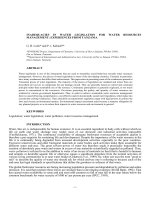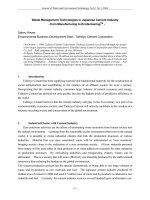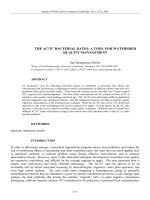Template commercial capability toolkit subcontractor management procedures
Bạn đang xem bản rút gọn của tài liệu. Xem và tải ngay bản đầy đủ của tài liệu tại đây (189.36 KB, 3 trang )
D12 Example Subcontractor Management Procedures
How to use this template
This document is an example of the procedures that an Indigenous business could introduce
to assist in the management of its subcontractors.
It is important to note that the subjects covered in a subcontractor management policy may
vary depending on the extent of subcontracting in the business and the size of the
subcontracts that exist (e.g. if an Indigenous business only has one subcontractor in place for
a relatively small piece of short-term work then they may not need to implement all of these
procedures. However, this template provides an example that a company can then tailor to
their own needs.
Note - This document is an example and may not be appropriate for all businesses.
1
Management practices
Successful projects that involve subcontractors all exhibit similar characteristics.
They all have clear and unambiguous subcontracts established that include a
Statement of Work.
The efforts of all subcontractors are integrated into a cohesive project plan
with all subcontractors understanding where their efforts fit into the overall
picture.
The formal and informal interfaces between the prime contractor and the
subcontractors, as well as among the subcontractors, are documented.
Before starting specific work, the subcontractors are granted authorisation to
proceed.
A formal team building process is established and implemented.
These practices all contribute to reducing the risk of misunderstandings or isolationism
2
Establishing clear subcontracts
Each subcontractor will have a legally binding, written contract that defines the following
items.
a. The legal names of the parties involved in the contract will be specified.
b. The scope of the contracted work (contained in an attached Statement of Work), will
be described in terms of:
i.
the responsibilities and authorities of each party to the contract,
ii.
a clear definition of the deliverables and minimum content to be provided
by the subcontractor,
iii.
a clear definition of the services to be provided by the subcontractor,
iv.
any and all constraints imposed on the subcontractor by the prime
contractor, such as schedule constraints, budget constraints, specific tools
to be used, and
v.
a clear statement of requirements for quality of deliverables and services
including the requirement to allow independent quality inspections of
materials and processes.
c. Appropriate terms and conditions which will be imposed on both the prime contractor
and the subcontractor will be identified.
d. The acceptance process will be clearly identified.
3
Work effort integration
The work of all subcontractors should be coordinated by the prime contractor to assure that
the efforts of all parties are integrated into a cohesive whole through the processes of
concurrent engineering and top-down project control.
4
Interfaces between prime contractor and subcontractors
Each subcontractor organisation will have a single point of contact with the prime contractor
for contractual matters. The subcontractors are expected to identify their own single point of
contact for contractual matters. On a day-to-day basis, all subcontractor personnel will be
free to interact with any prime contractor personnel as needed to fulfil the subcontract.
5
Work authorisation
Before starting to undertake work, the subcontractor must first receive a signed Work
Authorisation Form. The Work Authorisation Form will authorize the start of work, will
identify the deliverable(s) of the activity, will identify budget and schedule constraints, will
identify the responsible manager, and will identify the reviewers and acceptors of the
products or services. When the authorised work is complete, the Work Authorisation Form
will be closed, and the authorization withdrawn.
6
Progress reporting
The contractors must keep [INSERT COMPANY NAME] aware of the progress of their
project work on a regular basis. The subcontractors will report progress on a weekly or
monthly basis as required by the contract manager.
Format of progress reports
The progress reports submitted by subcontractors to the [INSERT COMPANY NAME]
project team will be in the form of a weekly progress report or monthly progress report. The
report will identify:
a. authorised work that was scheduled to be performed during the period,
b. progress made against that authorised work presented as:
1.
a textual description of progress,
2.
a list of internal milestones attained,
3.
an accounting of the hours billed against that job by all subcontractor
personnel, and
4.
an assessment of the time (in hours) remaining to complete the activities,
c. a list of unplanned, but authorised work that was conducted, identifying the
number of hours spent,
d. authorised work that is scheduled to be performed during the next week,
including any internal milestones expected to be reached, and
e. a brief description of any problems encountered in performing the activities of
the Cost Account or warnings of schedule slippage.
The Progress Reports will be reviewed by their contract manager. Variance reports will be
provided to Project Managers should the variance exceed the acceptable thresholds.
6.1
Contractor Issues Meetings
The Contract Manager will meet with the subcontractor on a regular basis (e.g. weekly or
fortnightly) to discuss issues of concern to either party. The subcontractor delegate is usually
a senior employee of the subcontractor who is not directly involved in the delivery of
products or services. These meetings exist to facilitate the project and to remove any
roadblocks to success.
6.2
Milestone Reviews
At key contractual milestones, a formal review will be conducted to assess the extent to
which the subcontractor has delivered against their contracted KPI’s and targets. Topics
covered depend on the milestone but could include such items as:
a. where we are in the overall project schedule,
b. an overview presentation of the key points contained in the project
deliverables that comprise that milestone,
c. a briefing on the quality of work achieved to date,
d. a briefing on the budget and schedule status with major variances clearly
highlighted and plans for corrective action presented, and
e. discussion of any concerns and areas of poor contractor performance.).









